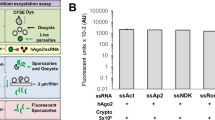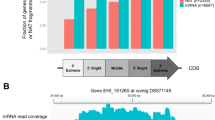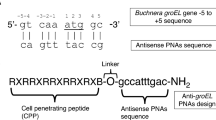Abstract
Peptide nucleic acids (PNAs) may be a potent tool for gene function studies in medically important parasitic organisms, especially those that have not before been accessible to molecular genetic knockout approaches. One such organism is Entamoeba histolytica, the causative agent of amebiasis, which infects about 500 million people and is the cause of clinical disease in over 40 million each year, mainly in the tropical and subtropical world. We used PNA antisense oligomers to inhibit expression of an episomally expressed gene (neomycin phosphorotransferase, NPT) and a chromosomal gene (EhErd2, a homolog of Erd2, a marker of the Golgi system in eukaryotic cells) in axenically cultured trophozoites of E. histolytica. Measurement of NPT enzyme activity and EhErd2 protein levels, as well as measurement of cellular proliferation, revealed specific decreases in expression of the target genes, and concomitant inhibition of cell growth, in trophozoites treated with micromolar concentrations of unmodified antisense PNA oligomers.
This is a preview of subscription content, access via your institution
Access options
Subscribe to this journal
Receive 12 print issues and online access
$209.00 per year
only $17.42 per issue
Buy this article
- Purchase on Springer Link
- Instant access to full article PDF
Prices may be subject to local taxes which are calculated during checkout




Similar content being viewed by others
References
Bloom, B. & Cerami, A. Biomedical science and the third world: under the volcano. Ann. NY Acad. Sci. 569, 36–44 (1989).
Hyrup, B. & Nielsen, P. Peptide nucleic acids (PNA): synthesis, properties and potential applications. Bioorg. Med. Chem. 1, 5–23 (1996).
Soomets, U., Hallbrink, M. & Langel, U. Antisense properties of peptide nucleic acids. Front. Biosci. 4, D782–786 (1999).
Pooga, M. et al. Cell penetrating PNA constructs regulate galanin receptor levels and modify pain transmission in vivo. Nat. Biotechnol. 16, 857–861 (1998).
Branden, L.J., Mohamed A.J. & Smith, C.I. A peptide nucleic acid–nuclear localization signal fusion that mediates nuclear transport of DNA. Nat. Biotechnol. 17, 784–787 (1999).
Cutrona, G. et al. Effects in live cells of a c-myc anti-gene PNA linked to a nuclear localization signal. Nat. Biotechnol. 18, 300–303 (2000).
Good, L. & Nielsen, P.E. Inhibition of translation and bacterial growth by peptide nucleic acid targeted to ribosomal RNA. Proc. Natl. Acad. Sci. USA 95, 2073–2076 (1998).
Good, L. & Nielsen, P.E. Antisense inhibition of gene expression in bacteria by PNA targeted to mRNA. Nat. Biotechnol. 16, 355–358 (1998).
McLaughlin, J. & Aley, S. The biochemistry and functional morphology of the Entamoeba. Protozoology 32, 221–240 (1985).
Bakker-Grunwald, T. & Wöstmann, C. Entamoeba histolytica as a model for the primitive eukaryotic cell. Parasitol. Today 9, 27–31 (1993).
Bhattacharya, A., Satish, S., Bagchi, A. & Bhattacharya, S. The genome of Entamoeba histolytica. Int. J. Parasitol. 30, 401–410 (2000).
Petri, W.A. & Ramakrishnan, G. Applying antisense technology to the study of Entamoeba histolytica pathogenesis. Trends Microbiol. 7, 471–473 (1999).
Diamond, L.S., Harlow, D.R. & Cunnick, C.C. A new method for the axenic cultivation of Entamoeba histolytica and other Entamoeba. Trans. Roy. Soc. Trop. Med. Hyg. 72, 413–432 (1978).
Martínez-Palomo, A. The biology of Entamoeba histolytica. (John Wiley & Sons, Chichester, England; 1982).
López-Revilla, R. & Gomez, R. Entamoeba histolytica, E. invadens, and E. moshkovskii: fluctuation of the DNA content of axenic trophozoites. Exp. Parasitol. 44, 243–248 (1978)
Willhoeft, U. & Tannich, E. The electrophoretic karyotype of Entamoeba histolytica. Mol. Biochem. Parasitol. 99, 41–53 (1999).
Bracha, R., Nuchamowitz, Y., Leippe, M. & Mirelman, D. Antisense inhibition of amoebapore expression in Entamoeba histolytica causes a decrease in amoebic virulence. Mol. Microbiol. 34, 463–472 (1999).
Ankri, S. et al. Antisense inhibition of expression of the light subunit (35 kDa) of the Gal/GalNac lectin complex inhibits Entamoeba histolytica virulence. Mol. Microbiol. 33, 327–337 (1999).
Semenza, J.C., Hardwick, K.G., Dean, N. & Pelham, H.R.B. ERD2, a yeast gene required for the receptor-mediated retrieval of luminal ER proteins from the secretory pathway. Cell 61, 1349–1357 (1990).
Sanchez-Lopez, R. et al. Cloning and expression of the Entamoeba histolytica Erd2 gene. Mol. Biochem. Parasitol. 92, 355–359 (1998).
Tyler, B.M. et al. Peptide nucleic acids targeted to the neurotensin receptor and administered i.p. cross the blood–brain barrier and specifically reduce gene expression. Proc. Natl. Acad. Sci. USA 96, 7053–7058 (1999).
Giovine, M. et al. Synthesis and characterization of a specific peptide nucleic acid that inhibits expression of inducible NO synthase. FEBS Lett. 426, 33–36 (1998).
Dhar, S.K., Vines, R.R., Bhattacharya, S. & Petri, W.A. Ribosomal DNA fragments enhance the stability of transfected DNA in Entamoeba histolytica. J. Eukaryot. Microbiol. 45, 656–660 (1998).
Platt, S.G. & Yang, N.S. Dot assay for phosphotransferase activity in crude cell extracts. Anal. Biochem. 162, 529–535 (1987).
Acknowledgements
This work was supported in part by CONACyT (Consejo Nacional de Ciencia y Technología) grant 27826-N (Mexico), Dirección General de Asusntos del Personal Académico grant 207097 (Mexico), a collaboration travel grant from the Centro Nazionale per la Ricerca (Italy) and CONACyT (Mexico). We wish to thank Angeles Gutiérrez, Xóchitl Alvarado, Enrico Millo, Gianluca Damonte, and Drs. Paul Lizardi, Mario Zurita and Eduardo Horjales.
Author information
Authors and Affiliations
Corresponding author
Rights and permissions
About this article
Cite this article
Stock, R., Olvera, A., Sánchez, R. et al. Inhibition of gene expression in Entamoeba histolytica with antisense peptide nucleic acid oligomers. Nat Biotechnol 19, 231–234 (2001). https://doi.org/10.1038/85671
Received:
Accepted:
Issue Date:
DOI: https://doi.org/10.1038/85671
This article is cited by
-
Combination of a new generation of PNAs with a peptide-based carrier enables efficient targeting of cell cycle progression
Gene Therapy (2004)
-
The many faces of PNA
International Journal of Peptide Research and Therapeutics (2003)
-
PNAs as novel cancer therapeutics
International Journal of Peptide Research and Therapeutics (2003)
-
Peptide nucleic acids as epigenetic inhibitors of HIV-1
International Journal of Peptide Research and Therapeutics (2003)
-
Getting sense and finding function in protozoa
Nature Biotechnology (2001)



